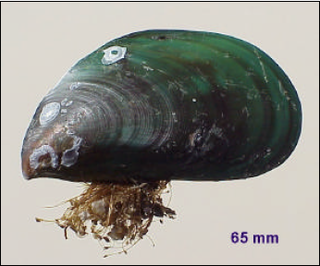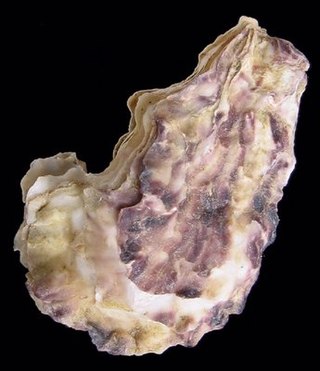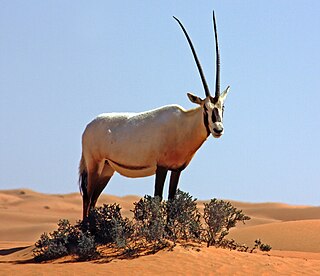
A pearl is a hard, glistening object produced within the soft tissue of a living shelled mollusk or another animal, such as fossil conulariids. Just like the shell of a mollusk, a pearl is composed of calcium carbonate in minute crystalline form, which has deposited in concentric layers. The ideal pearl is perfectly round and smooth, but many other shapes, known as baroque pearls, can occur. The finest quality of natural pearls have been highly valued as gemstones and objects of beauty for many centuries. Because of this, pearl has become a metaphor for something rare, fine, admirable and valuable.

Bivalvia, in previous centuries referred to as the Lamellibranchiata and Pelecypoda, is a class of marine and freshwater molluscs that have laterally compressed bodies enclosed by a shell consisting of two hinged parts. As a group, bivalves have no head and they lack some usual molluscan organs, like the radula and the odontophore. The class includes the clams, oysters, cockles, mussels, scallops, and numerous other families that live in saltwater, as well as a number of families that live in freshwater. The majority are filter feeders. The gills have evolved into ctenidia, specialised organs for feeding and breathing. Most bivalves bury themselves in sediment, where they are relatively safe from predation. Others lie on the sea floor or attach themselves to rocks or other hard surfaces. Some bivalves, such as the scallops and file shells, can swim. Shipworms bore into wood, clay, or stone and live inside these substances.

Pinctada is a genus of saltwater oysters, marine bivalve mollusks in the family Pteriidae. These pearl oysters have a strong inner shell layer composed of nacre, also known as "mother of pearl".

Cultured pearls are pearls which are formed within a cultured pearl sac with human intervention in the interior of productive living molluscs in a variety of conditions depending upon the mollusc and the goals. Having the same material as natural pearls, cultured pearls can be cultivated in seawater or freshwater bodies. Nowadays, over 95% of the pearls available on the market would be cultured pearls.

The Laccadive Sea, also known as the Lakshadweep Sea, is a body of water bordering India, the Maldives, and Sri Lanka. It is located to the southwest of Karnataka, to the west of Kerala and to the south of Tamil Nadu. This warm sea has a stable water temperature through the year and is rich in marine life, the Gulf of Mannar alone hosting about 3,600 species. Mangaluru, Kasaragod, Kannur, Kozhikode, Ponnani, Kochi, Alappuzha, Kollam, Thiruvananthapuram, Tuticorin, Colombo, and Malé are the major cities on the shore of the Laccadive Sea. Kanyakumari, the southernmost tip of peninsular India, also borders this sea.

Perna viridis, known as the Asian green mussel, is an economically important mussel, a bivalve belonging to the family Mytilidae. It is harvested for food but is also known to harbor toxins and cause damage to submerged structures such as drainage pipes. It is native in the Asia-Pacific region but has been introduced in the Caribbean, and in the waters around Japan, North America, and South America.

Mytilopsis leucophaeata is a species of small bivalve mollusc in the false mussel family, Dreissenidae. It is commonly known as Conrad's false mussel or the dark false mussel.

Pinctada albina is a species of pearl oyster of the genus Pinctada, known as the sharks bay shell. Another common name is the Arafura shell. It is called the "Amami gai" in Japan.

The Portuguese oyster is a species of oyster found in the southwest Iberian Peninsula, closely related to the Pacific oyster. Although first identified as a native European species, genetic studies have suggested the Portuguese oyster originated from the Pacific coast of Asia and was introduced to Europe by Portuguese trading ships in the 16th century. The species is usually found in coastal river mouths and estuaries.

Linatella caudata, common name : the Girdled triton or Poulsen's Triton, is a species of predatory sea snail, a marine gastropod mollusk in the family Cymatiidae.

Pinctada maxima is a species of pearl oyster, a marine bivalve mollusk in the family Pteriidae, the pearl oysters. There are two different color varieties: the Gold-lipped oyster and the Silver-lipped oyster. These bivalves are the largest pearl oysters in the world. They have a very strong inner shell layer composed of nacre, also known as "mother of pearl" and are important to the cultured pearl industry as they are cultivated to produce South Sea pearls.
Valeriy Valeryevich Zyuganov (Russian: Зюганов Валерий Валерьевич, born 31 July 1955 in Yangiyo‘l city, is a Soviet and Russian biologist, and Doctor of Biological Sciences. He is the pupil and follower of professors V.V. Khlebovich,the Zoological Institute of the Russian Academy of Sciences and Yu. A. Labas.A.N. Severtsov Institute of Ecology and Evolution of the Russian Academy of SciencesArchived 2007-12-13 at the Wayback Machine

Saccostrea cucullata, the hooded oyster or Natal rock oyster, is a species of rock oyster found mainly in the Indo-Pacific Ocean.

Pinctada mazatlanica is a species of tropical marine bivalve mollusc in the family Pteriidae, the pearl oysters. It is known by the English common names pearl oyster, Mazatlan pearl oyster, and Panama pearl oyster. Spanish common names include madre perla, and ostra perlifera panameña. This mollusc was first described to science in 1856 by conchologist Sylvannus Charles Thorp Hanley. Pinctada mazatlanica produces gem-quality pearls and was the basis of a pearling industry in the Gulf of California for centuries.
Pinctada fucata, the Akoya pearl oyster (阿古屋貝), is a species of marine bivalve mollusk in the family Pteriidae, the pearl oysters. Some authorities classify this oyster as Pinctada fucata martensii. It is native to shallow waters in the Indo-Pacific region and is used in the culture of pearls.

Pteria penguin, commonly known as the penguin's wing oyster, is a species of marine bivalve mollusk in the family Pteriidae, the pearl oysters. It is native to the western and central Indo-Pacific region and is used for the production of cultured pearls. The generic name comes from Greek πτερον (pteron) meaning wing.

Pinctada margaritifera, commonly known as the black-lip pearl oyster, is a species of pearl oyster, a saltwater mollusk, a marine bivalve mollusk in the family Pteriidae. This species is common in the Indo-Pacific within tropical coral reefs.
Pinctada longisquamosa, sometimes called scaly pearl osters, are a small species of pearl oyster found in the western Atlantic. They are distinguished by unique prismatic shell structures which protrude from the outer shell.

The wildlife of Qatar includes the peninsula's flora and fauna and their natural habitats. The country's terrestrial wildlife includes numerous small nocturnal mammals, a number of reptiles which mainly consist of lizard species, and arthropods. Aquatic animals primarily include fish, shrimp and pearl oysters. The desert and the shoreline form an important resting site for migratory bird species during autumn and spring. Urban and agricultural developments have led to an increase in bird species.
















